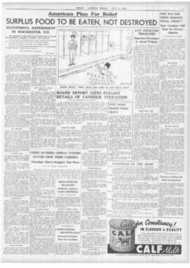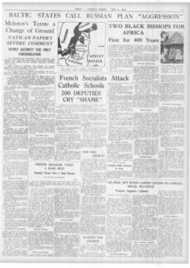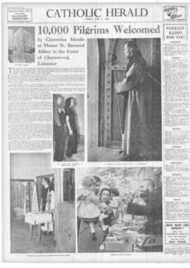Page 9, 9th June 1939
Page 9

Report an error
Noticed an error on this page?If you've noticed an error in this article please click here to report it.
Tags
Share
Related articles
White Church Or Black?
Negro To Be A Bishop
Of Racism" U.s.a. View Of Native Bishops
1939 A Great Year For The Missions
Archbishop Hits Out At 'utopia' Warning
TWO BLACK BISHOPS FOR AFRICA First for 400 Years
A.MPIONS OF THE POLICY OF NATIVE CLERGY WILL BE REJOICING, WHILE EXTREME "RACIALISTS" WILL BE INFURIATED BY THE LATEST APPOINTMENTS ISSUED BY THE PROPAGANDA FIDEL Both Uganda and Madagascar are to have Bishops from among their own people, and thereby Africa comes into line with India, China and Japan, who have been able to boast their own Bishops for some years.
Mgr. Joseph Kiwanuka is to be the first Vicar Apostolic of Masaka, in Uganda, while Mgr. Ignatius Ramarosandratana becomes the head of the Vicariate of Miarinarivo, in Madagascar.
It is clear that Pope Pius XI] proposes to continue the policy of
his predecessor, who with his own hands raised several native bishops to the plenitude of the priesthood hard by the tomb of the Prince of the Apostles.
First Since 1 6th Century
As in so many other things, the late Pope was enabled to bring about. much that had been hoped for by his predecessors. Innocent XI in the seventeenth century had said: "Better one native priest than 50.000 baptisms."
Leo XIII prophesied that India's sons would convert her. Benedict XV dwelt upon the peculiar power of those who are of the same birth and character to evangelise their own brethren,
But it remained for Pius XI, in the violently nationalistic post-war period, to carry out the policy in full; on three separate occasions he consecrated Bishops for the missions : in October, 1926, the first six for China; two years later a Japanese; and in .1933 three more Chinese, together with an Annamite and an Indian.
There have, until now, only been two black bishops in Africa since the days of St. Augustine, when the whole of North Africa was Christian. They were both members of a royal clan living on the Congo, and were consecrated about 1520 with a view to the conversion of their people, but Pope Leo X's hopes were shattered because one died on the way back from Rome, and their kingdom was soon afterwards broken up.
Catholic Uganda Of late years there has been much speculation as to which part of Africa would produce the third black bishop of modern times; twenty years ago there were scarcely more than a score of priests to choose from, but ten years later 'an enthusiastic missionary review put out one issue dedicated " to the next black bishop." Now it will be interesting to see which of the new prelates will earn the long-awaited title.
The whole history of the evangelisation of East Africa is quite modern, for it is only seventy years since Livingstone " opened it up," Bo it is easy to understand the doubts and scruples of the reactionary party which has not been by any means a small one; but this decision should satisfy even the most cautious that their fears are not shared by Rome.
Although the Faith has not been established in Uganda for more than 60 years, the second and even third generation of Catholics are now numerous enough (300,000) to deserve a bishop of their own. and now that well-tried priests are available it is natural that a start should be made In the most Catholic district of Iviasaka, which is not far from the scene of the martyrdom of the first Christians—widely venerated to-day as the patrons of Catholic Uganda.
150 Black Priests Thanks to the plans nf Bishop Hirthwho, in 1893, when the Uganda Mission was only just emerging from its stormy beginnings, opened the first seminary— Bishop Birraux will be able to hand over the care of Masaka to his new helper with confidence; for although it was twenty years before the first priests were ready, four hundred candidates had tried to satisfy the by no means easy requirements, and to-day one-third of the Vicariate is run by black priests.
Altogether there are some 150 native priests in the Great Lake district, and they form about half of the total for the whole of Africa; a good number of them have been trained by the White Fathers, who are responsible for no fewer than 22 seminaries in that area to-day, in which 2,000 sentivarians (17Y, being carefully prepared.
The hopes of these young men and of all their kinsfolk will be raised by the new appointment; there will be great rejoicing among the whole Baganda people as well, but not less happy will be those veteran missionaries whose labours will now seem fittingly rewarded by this last step towards a really indigenous hierarchy.
Among them the happiest will doubtless be Bishop Streicher, whose labours in Uganda began before the new bishop was born, and who has probably been watching his footsteps for the greater part of this time.
The Church In Madagascar
Madagascar is an island almost a thousand miles long, lying off the mainland of Africa in the Indian Ocean. It is a French possession; a few of the missions are old, some of them dating back several hundred years, but their history has been repeatedly interrupted, and here, too, it is only in the last seventy years that serious progress has been made. Out of a total population of nearly four million, to-day over 500,000 are Catholic and about the same number Protestant, The people are not of the same negro stock as the Bantu of the mainland; although they are dark-skinned they have more in common with the Malays and the Polynesians.
The Catholics owe their faith to the untiring energy of French missionaries, who number about 200, while the Malagasi priests are little more than two score strong.
In 1933, part of the Vicariate of Tananarive, which is administered by Jesuit Fathers, was erected into a separate mission area which now falls to Mgr. Ramarosa.ndratana. In this the Jesuits will be following precedents in India where they have been quick to respond to the demand for "Indianising " the clergy.
Contrast In Careers
If, as would seem to be the case, the new Malagasi Bishop has been trained by the Jesuit Fathers, this would account for the difference between his age (48) and that of the new Baganda Bishop, who is eight years his junior.
Unlike the White Fathers, who are content to teach enough Latin for priestly needs, the Jesuit tradition requires their students to study the classical authors as well, and this, together with a thorough grounding in French as well as the native tongue. naturally puts back the beginning of pastoral work.
The careers of these two pioneers will be watched with all the sympathy that their weighty responsibility demands, not only in their own countries, but wherever the full development of the Church Universal is awaited and prayed for.
blog comments powered by Disqus

















